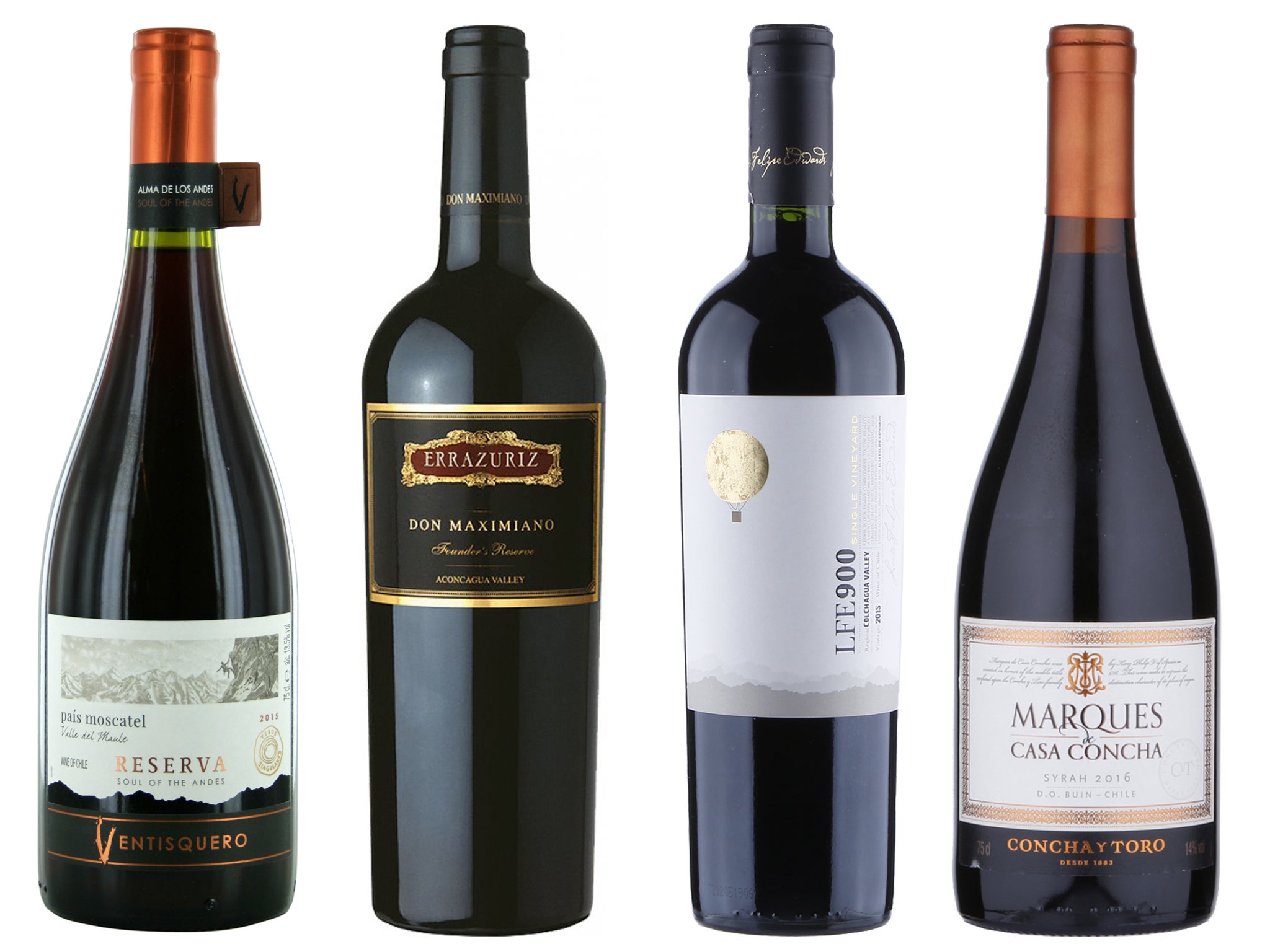The Independent's journalism is supported by our readers. When you purchase through links on our site, we may earn commission.
Seven sensational red wines from Chile
Chile has often been the go-to for quality, budget wines but the country has moved on and is also producing some serious bottles for the dinner table, writes Terry Kirby

Chile might be a southern hemisphere, Pacific-rim nation on the other side of the Andes to us, but ever since the Spanish conquistadors arrived in the 16th century, its winemaking traditions, blessed with a Mediterranean-type climate and cooling ocean breezes – to temper the higher temperatures – have been firmly rooted in those of Europe and, ironically, more allied to France than Spain.
The country also prospered from not being subject to the phylloxera louse, consequently boosting production when the blight devastated French vineyards. And since modern winemaking really took off in the late 1980s and early 1990s, Chile has grown to become one of the biggest wine exporters in the world, in fifth place behind Europe’s big three of Spain, France and Italy, and Australia. For many of us, perhaps similarly to Australian wines, its familiar and budget labels have been a staple of corner shop and supermarket shelves, with reassuring European varietals – such as cabernet sauvignon, sauvignon blanc, merlot and pinot noir – prominent on the labels. If you were looking for a decent quality, sub-£10 bottle, Chile was often the answer.
But it has also moved on a bit and there are now some more serious wines being produced, more for the dinner table than something for casual drinking; wines that celebrate neglected grapes and offer new takes on established ones.
So, next time you want a bottle for a midweek treat or something for a special occasion, here are some suggestions from Chile. First of all, if it’s a better than normal bottle for that pizza night, try the Marques de Casa Concha Syrah 2018 (£13.00 tesco.com; ocado.com) from Chile’s largest vineyard owner-producer, Concha y Toro, which produces budget wines and much more expensive bottles. This background demonstrates itself in a wine that is definitely a cut above the average for a supermarket wine – rich, velvety aromas of violets and mint, and tastes of chocolate and spice.
Taking the price point up a little, but staying with the same brand, there is the Marques de Casa Concha Etiqueta Negra DO Puente Alto Cabernet Sauvignon 2018 (£14.50 thewinesociety.com), with grapes taken from a 650-metre-high vineyard in the Puente Alto region near Santiago. The high altitude gives freshness to the weighty cab-sauv, with some oak ageing to give complexity and soften the wine more, delivering a nicely balanced parcel. A great wine for a big steak or a vegetable casserole.
High-altitude grapes from the Colchagua valley also deliver freshness to the blend of syrah, petite syrah, grenache and mourvedre in the LFE 900 Single-Vineyard 2015 (£16.99 or £14.99 if bought as part of mixed six bottle purchase, majestic.co.uk), which delivers intense, complex, robust brambly fruit flavours; if you like southern Rhone-style GSM blends, you will love this. Just remember that both of these latter two wines come in at 14.5 abv, so will pack something of an alcoholic punch.
But there are two grapes that Chile has really made into its own distinctive style: carmenere and pinot noir. The former, once used in bordeaux blends, was initially and incorrectly labelled as merlot until scientific analysis determined that it was the otherwise neglected but now justly celebrated carmenere. On its own, the grape makes wines of lovely freshness and succulence, with characteristic coffee and chocolate notes underpinning black cherry and dark plum flavours, not unlike a weighty beaujolais villages wine. A great example of the style is the gorgeously silky Errazuriz Max Carmenere 2018 (£15.95 winedirect.co.uk); like all these wines, it is adaptable for roast meats, hard cheeses and serious vegetable dishes.
Chile has also shown that it can produce premium pinot noir, even under challenging fog-bound desert-like conditions, as in the Vina Ventisquero Tara pinot I wrote about last summer and here is another slightly more affordable and available Vina Ventisquero wine, the Heru Pinot Noir 2016 (£23.99 sohowine.co.uk) from another hillside in the Casablanca Valley, cooled by fog and Pacific breezes. It is a chewy pinot, with sublime strawberry and raspberry flavours with some oaky, earthy and spicy complexity. Ideal with slow-roasted duck or lamb.
Vina Ventisquero has also been among those pioneering the revival of pais, a once obscure grape used for bulk, cheap red wine, but that can, with proper care, produce fresh, medium-bodied, juicy reds, full of cherry and chocolate flavours – as well as lovely pink sparkling wines. Check out this pais red, blended with just 15 per cent muscatel: the Ventisquero Pais Moscatel Reserva 2017 (£10.95 davywine.co.uk) is soft, rounded and satisfying, with lovely freshness. Ideal with lighter meats or even, if fridge or cellar-cooled, with a tuna steak.
Finally back to Errazuriz, whose founders were said to be the first to import French vines, like cabernet sauvignon and merlot, and it is in memory of one of those that the estate created the Bordeaux-style Errazuriz Don Maximiano Founder’s Reserve 2013 (£55.14 thedrinkshop.com; £55.95 winedirect.co.uk), a complex and elegant blend of cabernet sauvignon, malbec, carmenere and petit verdot grapes from the Conchagua Valley, with big flavours of black fruits, tobacco, tar and some green herbs but with a remarkable freshness delivered by the latter three grapes. Decant well in advance and sip with special meals. A big bottle in every way and a tribute to the country’s ability both to produce a great wine that is unmistakably Chilean and to recognise its heritage – a very French-inspired blend with a Spanish name – from the other side of the world.
Join our commenting forum
Join thought-provoking conversations, follow other Independent readers and see their replies
Comments



Bookmark popover
Removed from bookmarks